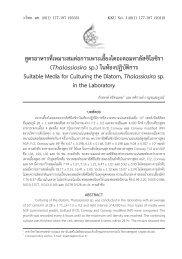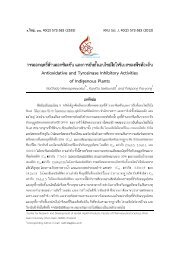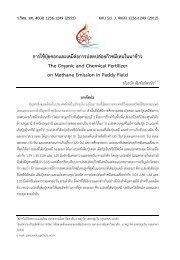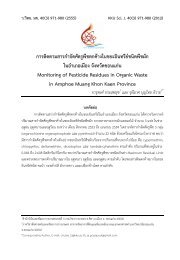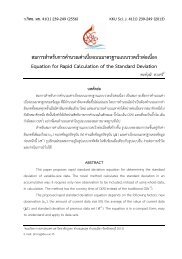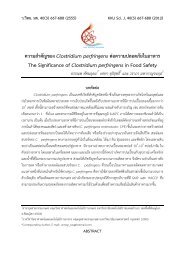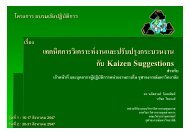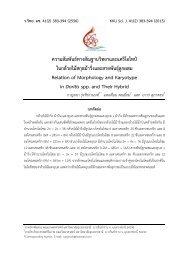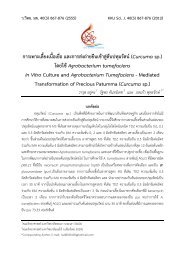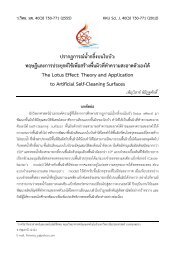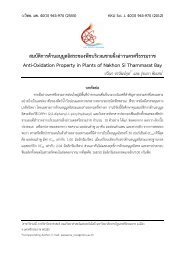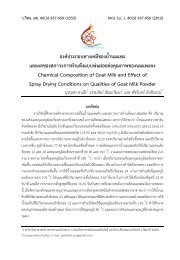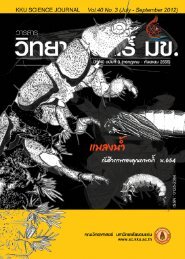Review
Review
Review
Create successful ePaper yourself
Turn your PDF publications into a flip-book with our unique Google optimized e-Paper software.
ß“π«‘®—¬<br />
«“√ “√«‘∑¬“»“ µ√å ¡¢. ªï∑’Ë 39 ©∫—∫∑’Ë 1 107<br />
3. The Automated Inkless Fingerprint<br />
Imaging software (Nanakorn et al., 2006; 2007; 2008).<br />
4. MI questionnaire (Sintuwong, 2002; with<br />
written permission) which consists of 80 questions<br />
of the 8 MI categories (10 questions for each MI)<br />
scoring in 5 levels from 0 to 4 (This is not like me<br />
at all = 0, This is a bit like me = 1, This is<br />
sometimes like me = 2, I am like this more often<br />
than not = 3, I am always like this = 4).<br />
Sample collection: Prior to answering the<br />
MI questionnaire and scanning of fingertips, signed<br />
informed consents were obtained. Each subjectûs ten<br />
fingertips were scanned using the fingerprint sensor<br />
coupled with the Automated Inkless Fingerprint<br />
Imaging Software. The scanning method is described<br />
elsewhere (Nanakorn et al., 2007; 2008). Briefly,<br />
researchers performed scanning by touching each<br />
subjectûs fingertips on a touchpad of the fingerprint<br />
sensor, starting from the left hand; thumb, index,<br />
middle, ring, little fingers, followed by the right<br />
fingers of little, ring, middle, index, and thumb.<br />
These fingertipsû images are stored into a data<br />
base as a portable digital format (PDF) file<br />
before printing. Subjects also answered the MI<br />
questionnaire by themselves.<br />
Data analyses: Types of fingerprint<br />
patterns were identified by the first author according<br />
to the standard method set by Cummins and Midlo<br />
(1943). Four main types of fingerprint patterns were<br />
classified as whorl, ulnar loop, radial loop, and arch.<br />
Reliability of the MI questionnaire was analyzed<br />
using the alpha Cronbach. Sex difference of each<br />
mean MI score was analyzed using an independent<br />
sample t-test. Relationships between types of<br />
fingerprint pattern and means of each MI score were<br />
analyzed using an analysis of variances (ANOVA)<br />
and the independent sample t-test. The SPSS for<br />
Windows version 17.0 (SPSS Inc. Chicago, IL, USA.)<br />
was used for statistical analyses at 95% level of<br />
confidence.<br />
Results<br />
Demographic characteristics<br />
Seventy two subjects were 43 males and<br />
29 females who identified themselves for training<br />
in Computers (20 persons = 27.8%), Physics (20<br />
persons = 27.8%), Mathematics (18 persons = 25.0%),<br />
and Biology (14 persons = 19.4%).<br />
Reliability<br />
Cronbachûs alpha of the 80 questions was<br />
equal to 0.917<br />
Multiple intelligence<br />
Descriptive analysis of mean scores of each<br />
MI by sex found that the intrapersonal intelligence<br />
of male subjects was higher than other MI (29.1+4.7;<br />
mean + standard deviation). The second and the<br />
third highest mean scores were logical-mathematical<br />
intelligence and musical intelligence (28.7+4.2,<br />
26.8+6.9, respectively). Female subjects also had<br />
the highest score of intrapersonal intelligence<br />
(27.5+3.5) followed by spatial intelligence (25.4+4.8),<br />
logical-mathematical intelligence (25.4+4.2), and<br />
interpersonal intelligence (25.3+4.3). Sex differences<br />
of MI mean scores analyzed by the independent<br />
sample t-test showed that male subjects had<br />
significantly higher mean MI scores than those of<br />
females [t (71)<br />
=3.22, p



